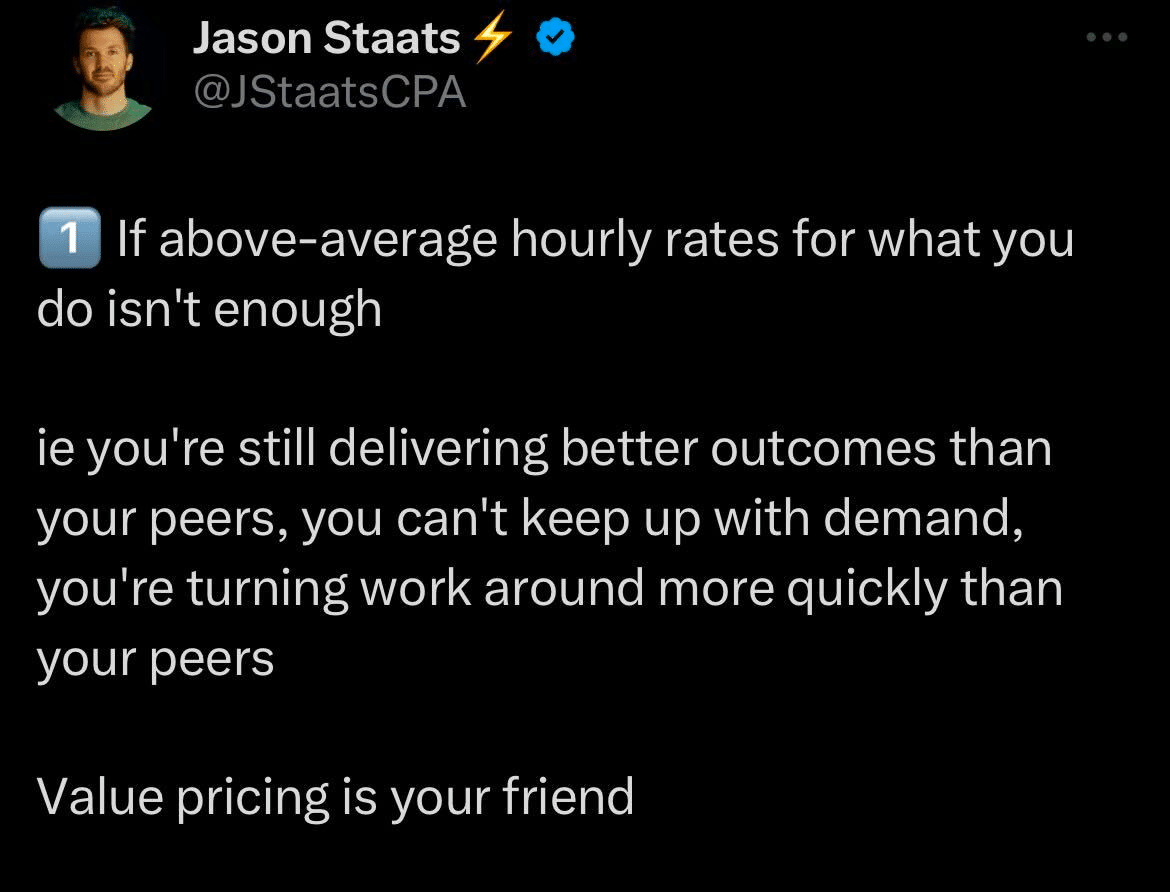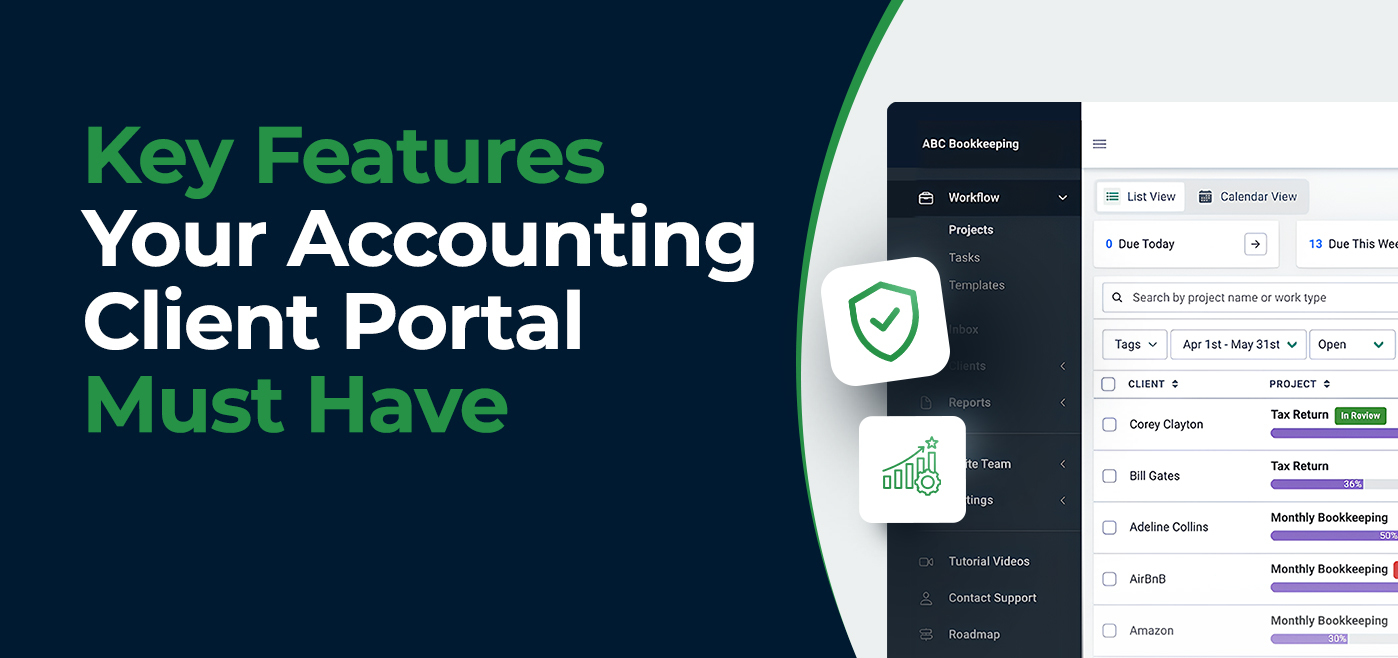Value-Based Pricing for Accounting Firms: The What, Why, and How (W/ Mark Wickersham)
Guest: Mark Wickersham
In this article
In the world of accounting, pricing services has traditionally revolved around hourly rates, leaving some feeling trapped. However, there is a better way to determine the worth of your services and ensure you are adequately compensated for the value you provide.
Enter value-based pricing, a strategy that takes into account the unique needs and goals of your clients while simultaneously reflecting the expertise and value your firm offers.
In this comprehensive article, we will explore what value-based pricing is, why it is crucial for accounting firms, and how you can implement it successfully.
In response to our question on what value means to clients, Loren Fogelman, Founder of Business Success Solution, had this to say:
It depends on which perspective you’re looking at it from. If you’re looking at what you value as a firm owner, then you’re going to consider time, cost and profit margin. However, if you’re looking at it from the perspective of your clients, then what they value is your expertise, your years of experience, your way of working with clients. And those things are more important than what you do"
Loren FogelmanYou can also watch the video below to get even more insights as shared by Mark Wickersham
What is Value-Based Pricing?
Value pricing is about setting a price based on the value to the customer, not based on how many hours something takes. It sounds really simple but it is difficult to implement in the real world"
Mark WickershamAs an accounting firm, your clients rely on your expertise and knowledge to navigate complex financial matters. Traditional hourly billing often fails to capture the value you bring beyond the number of hours worked. Here’s why value-based pricing is crucial for accounting firms:

1. Reflecting Expertise and Value
Value-based pricing enables you to showcase your expertise and the value you provide to clients. It acknowledges that your services extend beyond mere calculations and form filling.
As a customer, when we see a price, our brain goes off in its subconscious to go away and compare with something and come back in a nanosecond with some emotions like “that’s expensive” or “that’s a great deal”, which is why price psychology is so important”"
Mark WickershamImagine a small business owner seeking accounting services. They have been struggling with cash flow issues and need help to develop a robust financial plan. An accounting firm employing value-based pricing would assess the potential impact of their services on the client’s cash flow, revenue growth, and overall business success. The price quoted would reflect the value of the firm’s expertise in solving the client’s specific challenges.
By setting prices based on the value delivered, you ensure that your clients recognize and appreciate the strategic guidance and insights you offer.
2. Building Stronger Client Relationships
Value-based pricing fosters a stronger client-firm relationship by aligning your incentives with those of your clients. When you demonstrate that your primary goal is their success, clients are more likely to view you as a trusted partner rather than a transactional service provider. This, in turn, leads to long-term client relationships, increased client satisfaction, and higher client retention rates.
3. Competitive Advantage
In a crowded accounting industry, value-based pricing sets you apart from competitors who rely on traditional billing methods. Clients are often willing to pay a premium when they see the direct impact and value your firm provides. By leveraging this, you differentiate your firm and position yourself as a trusted advisor rather than a mere service provider, ultimately attracting more ideal clients to your practice.


Consider two accounting firms competing for a high-profile client. Firm A offers traditional hourly billing, while Firm B employs value-based pricing. The client, a growing technology company, is seeking guidance on tax planning and financial forecasting to support their expansion plans.
Firm B conducts a thorough assessment of the client’s goals, identifies potential tax-saving opportunities, and presents a comprehensive plan that outlines the financial benefits and growth potential.
The value-based pricing proposal from Firm B not only reflects the expertise and tailored approach but also demonstrates a clear understanding of the client’s needs. The client, recognizing the added value, chooses Firm B over Firm A, despite the potentially higher price.
Hourly pricing & fixed pricing are wrong because as you start to communicate what you do and its value, in your customers’ mind they will start to come up with what they are willing to pay which can be higher or lower than your fixed price"
Mark WickershamHow to Implement Value-Based Pricing
Now that the importance of value-based pricing for accounting firms has been emphasized, here is the step-by-step process to implement it effectively:
Step 1: Understand Your Clients
To implement value-based pricing successfully, you must have a deep understanding of your clients, their businesses, and their goals. Engage in open and meaningful conversations with your clients to identify their pain points, challenges, and aspirations. This understanding will enable you to align your services with their specific needs and quantify the value you can deliver.
When you are talking to your clients, you can’t ask them what’s the most they are willing to pay for a service because they will either not answer or they give you a wrong answer. This also gives them control during the negotiation process"
Mark WickershamTake the time to listen actively and ask probing questions. Learn about their industry, competitive landscape, and growth plans. The more you know about your clients, the better equipped you are to provide strategic advice and customized solutions that go beyond basic accounting services.
Step 2: Identify Key Value Drivers
Once you have a clear understanding of your clients, determine the key value drivers that your services can impact. These drivers can include areas such as revenue growth, cost savings, risk mitigation, or strategic decision-making.
Our goal as entrepreneurs is to figure out what is the maximum that they are willing to pay and we need to remember that everyone is willing to pay a different price. Hence, the need to price everyone individually"
Mark WickershamIdentify the specific metrics and outcomes that matter most to your clients. For example, if you work with small businesses, increasing revenue and reducing costs may be crucial. For larger corporations, risk mitigation and compliance could be top priorities. By understanding these value drivers, you can quantify the potential impact of your services and articulate the value you bring to the table.

Step 3: Develop Pricing Models
One of the ways to get 3 times a particular price is through menu pricing. This is basically coming up with different options and giving the customer the chance to choose. This is important because you don’t know how much somebody is willing to pay because we value things differently."
Mark WickershamBased on the identified value drivers, develop pricing models that align with the value you provide. While there are different approaches to value-based pricing, a few common models include:
- Fixed Project Fees: This model involves setting a fixed price for a specific project or engagement. It provides clarity for both parties and allows clients to budget accurately.
- Outcome-Based Pricing: With this model, the price is determined based on achieving specific outcomes or goals. For example, you could establish a pricing structure that ties the fee to cost savings or revenue growth achieved through your services.
- Tiered Pricing: This model offers different levels of service and pricing based on the value delivered. Clients can choose the tier that best aligns with their needs and budget, providing flexibility and scalability.
Consider the complexity of the work, the level of expertise required, and the potential impact on the client’s business when determining your pricing models. Ensure that your pricing is transparent, easily understandable, and reflects the unique needs of each client.
Step 4: Communicate the Value Proposition
Effectively communicating the value proposition of your pricing models is crucial to gaining client buy-in. Clients need to understand the benefits they will receive and how your services align with their goals. Clearly articulate the value you bring and the specific outcomes they can expect.
One of the most important skills we have to master is how we communicate value. What words do we use to communicate this value so that the client understands it?"
Mark WickershamUse real-life examples and case studies to demonstrate how your firm has delivered value to similar clients in the past. Highlight the tangible results achieved and the positive impact on their businesses. By showcasing your expertise and track record, you build trust and confidence in your value-based pricing approach.
Step 5: Monitor and Adjust
Once you have implemented value-based pricing, it’s important to monitor the outcomes and results your clients achieve through your services. Regularly collect feedback, track the value delivered, and evaluate the effectiveness of your pricing models. Are your clients experiencing the expected benefits? Are there areas for improvement?
Be open to feedback and be willing to make adjustments as necessary. This iterative process allows you to continuously enhance your pricing strategies and ensure a fair exchange of value. Regular communication and evaluation also strengthen the client relationship and demonstrate your commitment to their success.
Step 6: Evolve and Adapt
The business landscape is dynamic, and as an accounting firm, it’s crucial to adapt your pricing strategies to stay relevant and competitive. Keep a pulse on industry trends, emerging technologies, and changing client needs. Continuously evolve your value-based pricing models and explore innovative approaches to deliver even greater value to your clients.
You maybe interested in: Playbook: How to Price Accounting and Bookkeeping Services for Ultimate Profitability
Regularly assess your pricing models and evaluate their effectiveness. Are they still aligned with the evolving needs and expectations of your clients? Are there new value drivers that you can incorporate into your pricing strategy? Be open to exploring new approaches and adapting your pricing models as necessary to meet the changing landscape.
Don’t sell yourself short. No one will value you. Set a fair price for you, your book, your services, whatever it is that you have to offer. Most of us set way too low a price. Put it a little higher than you would normally be inclined to do. The worst that can happen is someone will come along and steal it"
John KremerRemember, value-based pricing is not a static strategy. It requires continuous evolution and adaptation to stay relevant and competitive in the accounting industry.
Conclusion
Implementing value-based pricing is a strategic decision that can transform the way accounting firms price their services and create meaningful partnerships with clients. By understanding your clients, identifying key value drivers, developing transparent pricing models, effectively communicating the value proposition, and continuously assessing and refining your approach, you can unlock the true worth of your services and establish long-term success.
Subscribe to Newsletter
We're talking high-value articles, expert interviews, actionable guides, and events.

Key Features Your Accounting Client Portal Must Have
By utilizing a client portal, you can eliminate the inefficiencies of manual methods and create a smoother workflow for both you and…
May 15, 2024

The 5 Best Avii Workspace Alternatives for Modern Firms
If, for whatever reason, Avii does not meet your long-term workflow needs, this review of the best Avii workspace alternatives should help…
May 08, 2024
